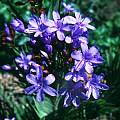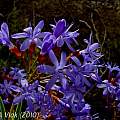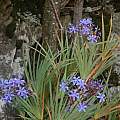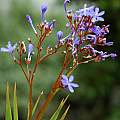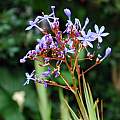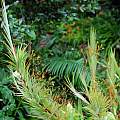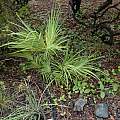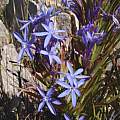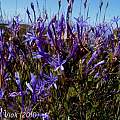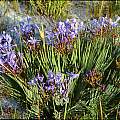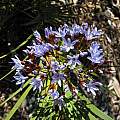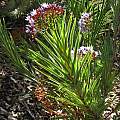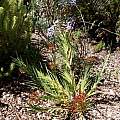Nivenia is a genus in the Iridaceae family with 11 species. It is a genus in a group referred to as South African woody irids. This fascinating and little studied group of plants that also includes the genus Witsenia with one species and Klattia with three species can grow to be true shrubs producing thickened woody stems that arise from woody caudices. Nivenia species are blue flowered shrubs with flat leaves arranged in a fan. The largest species and the one with the longest cultivation history, Nivenia corymbosa, can exceed nine feet in height with a woody base more than a foot and a half across! They may not qualify as geophytes, but are certainly related as monocots with a caudex and resprout after a fire. We include them as they are members of a family in which the majority of the species are geophytes.
Seeds are said to germinate better when treated with smoke water. For more information, consult Martin Grantham's excellent article on how to grow woody irids.
Nivenia binata Klatt flowers in the spring with flowers that range from pale blue to dark blue and up to a little over 3/4 in. across. The branching pattern of the inflorescence brings the flowers nearly into a single plane. It is a heterostylous species. Growing to about 50 cm tall, this species is endemic to the Swartberg Mountains over a range of conditions. The first photo by Andrew Harvie was taken in habitat at Seweweekspoort. The second photo is from the book Plants of the Klein Karoo courtesy of Jan and Anne Lise Schutte-Vlok.
Nivenia corymbosa (Ker Gawl.) Baker is a shrublet that grows along seeps and streams, in crevices in cliffs and rocky outcrops in the Western Cape Mountains. Growing from .5 to 2 m, it has erect to inclined stems, narrow lanceolate leaves and a large inflorescence of about many blue flowers on a terminal cluster. It flowers from January to March. One of the more widely grown species of this genus, it can be started from cuttings or seed. Seed should be sown in autumn and treated with smoke. To learn more consult this link. The first photo from Rod Saunders. The rest of the photos were taken by Mary Sue Ittner. The first three photos were taken in Rod and Rachel Saunders' yard in January 2010. The last photo was taken in Mary Sue's garden in California. Her plant was grown from seed sown in 1998. It still hasn't flowered in 2024, nor has it grown tall, but has interesting leaves.
Nivenia inaequalis Goldblatt & J.C.Manning grows to 1 m tall and has light to dark blue flowers with a long tube and narrow leaves. This species flowers in late spring and grows in fynbos. The photos below are from the book Plants of the Klein Karoo courtesy of Jan and Anne Lise Schutte-Vlok.
Nivenia stokoei (L.Guthrie) N.E.Br. has the largest flowers of the genus up to 1.5 in. across that vary from pale silvery blue to deep blue. The foliage is quite waxy glaucous. It grows in a limited coastal area in and around the Kogelberg Biosphere Reserve. When grown under artificial light the flowering time can be shifted. To learn more consult this link. Height range: 1-1.5 m. Photo #1 was taken by Martin Grantham in habitat in Kogelberg Biosphere Reserve. Photos 2-4 were taken by Nhu Nguyen and photo 5 was contributed by the UC Botanical Garden.
Information furnished by Martin Grantham in his Introduction to Woody Irids when it was the topic of the week on the Pacific Bulb Society list in July of 2003.
